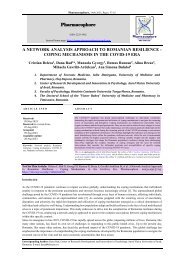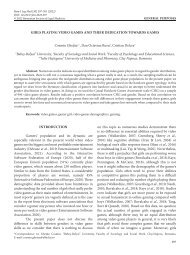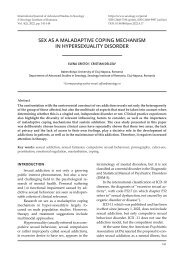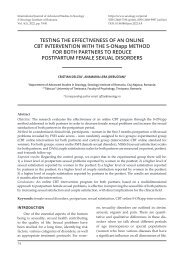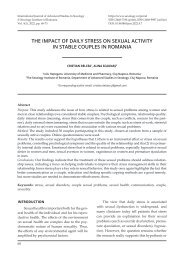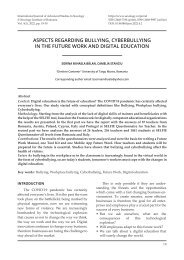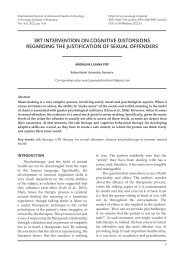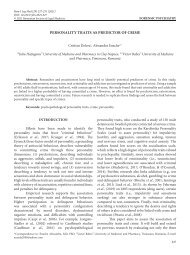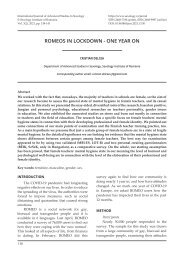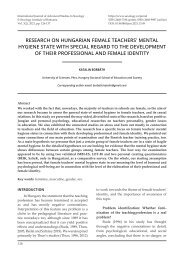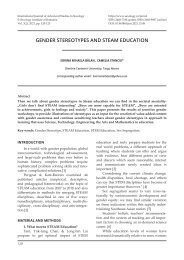Treatment of orgasm disorder in women with the digital S-ONapp method
Create successful ePaper yourself
Turn your PDF publications into a flip-book with our unique Google optimized e-Paper software.
International Journal <strong>of</strong> Advanced Studies <strong>in</strong> Sexology<br />
© Sexology Institute <strong>of</strong> Romania<br />
Vol. 4(1), 2022, pp. 41-50<br />
https://www.sexology.ro/jurnal<br />
ISSN 2668-7194 (pr<strong>in</strong>t), ISSN 2668-9987 (onl<strong>in</strong>e)<br />
DOI: 10.46388/ijass.2022.4.4<br />
TREATMENT OF ORGASM DISORDER<br />
IN WOMEN WITH THE DIGITAL S-<strong>ONapp</strong> METHOD<br />
MIRCELA ROSOIU 1 , CAMELIA STANCIU 2 , LOREDANA VÂȘCU 3<br />
1<br />
University <strong>of</strong> Bucharest, Romania; 2 “Dimitrie Cantemir“ University <strong>of</strong> Targu Mures, Romania;<br />
3<br />
Tibiscus University <strong>of</strong> Timișoara, Romania<br />
*Correspond<strong>in</strong>g author email:mircela.rosoiu18@gmail.com<br />
Abstract<br />
Objectives: The present body <strong>of</strong> work presents a case study address<strong>in</strong>g <strong>the</strong> development <strong>of</strong> sexual<br />
behaviors <strong>in</strong> a patient <strong>with</strong> primary an<strong>orgasm</strong>ia <strong>in</strong> order to reduce emotional distress manifested by<br />
guilt, embarrassment and performance anxiety, as well as learn<strong>in</strong>g new sexual patterns to <strong>in</strong>crease<br />
pleasure and sexual satisfaction. Specifically, we sought to create a positive attitude toward sexuality<br />
as part <strong>of</strong> mental health and <strong>in</strong>crease self-confidence <strong>in</strong> express<strong>in</strong>g one's sexuality. Reach<strong>in</strong>g <strong>orgasm</strong><br />
by <strong>the</strong> patient was not a stated goal, not to accentuate <strong>the</strong> distress, but <strong>the</strong> development <strong>of</strong> sexual behaviors<br />
aimed to <strong>in</strong>crease <strong>the</strong> duration and <strong>in</strong>tensity <strong>of</strong> arousal and more frequent manifestation <strong>of</strong><br />
sexual desire, designed to create <strong>the</strong> conditions for its occurrence.<br />
Method: This is a case study on a 44-year-old patient, dur<strong>in</strong>g 20 sex <strong>the</strong>rapy sessions <strong>of</strong> 1 hour each,<br />
for 22 weeks, May-September 2021. Assessment <strong>method</strong>s for Axis I and Axis II, anamnesis and cl<strong>in</strong>ical<br />
observation, structured, semi-structured and unstructured cl<strong>in</strong>ical <strong>in</strong>terviews (Delcea C., 2021) and<br />
<strong>in</strong>vestigation <strong>of</strong> medical, family, sexual, socio-cultural, and psycho-social history (<strong>in</strong>dividual completion)<br />
- MCMI III psychometric tests (Millon), Scale <strong>of</strong> Anxiety Hamilton, HRSA (SEC), PDA Affective<br />
Distress Pr<strong>of</strong>ile, Opris D., Macavei B. (SEC), YSQ-S3 Short Form Cognitive Questionnaire (SEC), DAS<br />
Dysfunctional Attitude Scale Beck A., Weissman A. ( SEC); For sexual test<strong>in</strong>g: Genogram <strong>of</strong> excitatory<br />
stimuli, (Delcea C., 2021), FSFI Female Sexual Function Index, Rosen M. 2000, FSDS Female Sexual<br />
Distress Scale, Derogatis, 2019, FOS Female Orgasm Scale, McIntyre, Smith, 2019, ORS The Orgasm<br />
Rat<strong>in</strong>g Scale, Mah K., B<strong>in</strong>ik, 2019, MISSA Multiple Indicators <strong>of</strong> Subjective Sexual Arousal, Mosher<br />
DL, 2019- SISES Sexual Inhibition / Excitation Scale, (Milhausen RR 2019). Methods used <strong>in</strong> sex <strong>the</strong>rapy<br />
<strong>in</strong>tervention (face to face): to identify stimuli <strong>of</strong> pleasure, arousal and sexual relaxation, hav<strong>in</strong>g as<br />
source <strong>the</strong> partner's body we used <strong>the</strong> Genogram <strong>of</strong> excitatory stimuli, <strong>the</strong> technique <strong>of</strong> anticipat<strong>in</strong>g<br />
excitatory stimuli and <strong>the</strong> technique <strong>of</strong> defocus<strong>in</strong>g irrelevant stimuli. (Delcea C., 2021). Sensate focus<br />
and directed masturbation to identify <strong>in</strong>dividual arousal stimuli, and self-monitor<strong>in</strong>g through journals.<br />
3. Cognitive restructur<strong>in</strong>g <strong>of</strong> dysfunctional cognitions. 4. Progressive desensitization, <strong>in</strong> <strong>the</strong> construction<br />
and practice <strong>of</strong> new excit<strong>in</strong>g sexual behaviors. 6. Psychoeducation. 7. Relaxation techniques<br />
(eg breath<strong>in</strong>g, m<strong>in</strong>dfulness).<br />
Results: Follow<strong>in</strong>g <strong>the</strong> standard psychological assessment, <strong>the</strong> patient has no Axis I and II emotional<br />
<strong>disorder</strong>s, and no history <strong>of</strong> sexual abuse. The MCMI pr<strong>of</strong>ile shows a person <strong>with</strong>out cl<strong>in</strong>ical personality<br />
<strong>disorder</strong>s, but a very high level <strong>of</strong> Distress (PDA), present cognitive schemas, Negativism and<br />
Need for approval that outl<strong>in</strong>es a possible anxious predisposition, as well as present dysfunctional<br />
attitudes <strong>of</strong> medium level, considered as predispositions for depression. Sexual test<strong>in</strong>g <strong>with</strong> <strong>the</strong> score<br />
sc = 19 FSDS scale, (Derogatis, LR 2002) The sexual distress scale <strong>in</strong> <strong>women</strong> shows that <strong>the</strong> patient has<br />
41
ROSOIU et al.<br />
a high level <strong>of</strong> stress that positively correlates <strong>with</strong> <strong>the</strong> existence <strong>of</strong> sexual dysfunction, manifested by<br />
feel<strong>in</strong>gs <strong>of</strong> shame, guilt , <strong>in</strong>adequacy, and average sexual satisfaction. From <strong>the</strong> 2 <strong>orgasm</strong> measurement<br />
scales, FOS (McIntyre - Smith, 2019) and ORS (Mah K., B<strong>in</strong>ik, Y., 2019) <strong>the</strong>re is a lack <strong>of</strong> experience<br />
<strong>of</strong> <strong>orgasm</strong> by <strong>the</strong> subject, throughout life and an <strong>in</strong>creased dissatisfaction. The FSFI Scale Index <strong>of</strong><br />
sexual function<strong>in</strong>g <strong>in</strong> <strong>women</strong> (Rosen R., 2000) shows <strong>the</strong> same difficulty <strong>in</strong> experienc<strong>in</strong>g <strong>orgasm</strong> <strong>in</strong> <strong>the</strong><br />
context <strong>in</strong> which sexual desire exists and <strong>the</strong> level <strong>of</strong> arousal is high, from <strong>the</strong> subjective assessment<br />
<strong>of</strong> <strong>the</strong> patient. Sexual desire - 4.2; Excitation - 5.1; Lubrication - 4.2; Orgasm - 1.2; Sexual satisfaction<br />
- 4.4; Disappearance - 0.9 (maximum = 6.0). The genogram <strong>of</strong> excitatory stimuli shows an <strong>in</strong>sufficient<br />
register <strong>of</strong> excitatory stimuli on <strong>the</strong> partner's body, 4 out <strong>of</strong> 8 (face, chest and arms) and an absent register<br />
<strong>of</strong> excitatory physical stimuli hav<strong>in</strong>g as source its own body, absent fantasies, unique, poor and<br />
repetitive scenarios.<br />
Conclusions: This is a patient <strong>with</strong>out mental <strong>disorder</strong>s <strong>with</strong> cl<strong>in</strong>ical significance, <strong>with</strong> predispositions<br />
for <strong>the</strong> <strong>in</strong>stallation <strong>of</strong> anxiety and depression, high level <strong>of</strong> distress. There is a poor sexual history<br />
and reduced and <strong>in</strong>adequate arousal. Absent fantasies, absent masturbation, dysfunctional cognitions<br />
about sex, "sex is unknown, forbidden, dangerous", register <strong>of</strong> excitatory stimuli on one's own<br />
absent body, and reduced for <strong>the</strong> partner's body, sexual pattern dur<strong>in</strong>g predom<strong>in</strong>antly passive sexual<br />
<strong>in</strong>tercourse, on receiv<strong>in</strong>g pleasure, focused on <strong>the</strong> partner's body. There is a lack <strong>of</strong> development <strong>of</strong><br />
arousal stimuli and consequently sexual behaviors ma<strong>in</strong>ta<strong>in</strong> <strong>orgasm</strong> dysfunction.<br />
Key words: Orgasm, Sexual arousal, Primary an<strong>orgasm</strong>ia, TOF, FOD, Orgasmic <strong>disorder</strong> <strong>in</strong> <strong>women</strong>,<br />
Arousal stimuli.<br />
INTRODUCTION<br />
Pleasure and <strong>orgasm</strong> are critical emotional<br />
states for adult sexuality, which is why it<br />
is necessary to ma<strong>in</strong>ta<strong>in</strong> a healthy life style<br />
<strong>in</strong> general and sexual and romantic health as<br />
well. Sexual pleasure is an important part <strong>of</strong><br />
every healthy sexual relationship. Orgasm is<br />
a unique, subjective experience <strong>of</strong> liv<strong>in</strong>g fully,<br />
physically and psychologically <strong>with</strong> sexual<br />
pleasure and satisfaction even to an altered<br />
state <strong>of</strong> consciousness. It is closely associated<br />
<strong>with</strong> <strong>the</strong> joy <strong>of</strong> liv<strong>in</strong>g life, happ<strong>in</strong>ess, love, sexual<br />
fulfillment, or <strong>the</strong> success <strong>of</strong> a relationship.<br />
It is a progressive accumulation <strong>of</strong> <strong>in</strong>creas<strong>in</strong>gly<br />
<strong>in</strong>tense sensations <strong>of</strong> pleasure and arousal to a<br />
peak followed by <strong>the</strong> release <strong>of</strong> sexual tension<br />
and <strong>the</strong> feel<strong>in</strong>g <strong>of</strong> physical and mental fulfillment,<br />
satisfaction and sexual relaxation. It is<br />
a part <strong>of</strong> our well-be<strong>in</strong>g and our physical and<br />
psychological health. It is not a luxury, but one<br />
<strong>of</strong> our rights to enjoy life and <strong>the</strong> mean<strong>in</strong>g attributed<br />
to <strong>in</strong>dividual sexuality can be an extremely<br />
powerful motivator for energization<br />
and <strong>in</strong>vigoration adapted to each age level.<br />
Orgasm is seen as a reward for sexual activity<br />
and it has a great importance <strong>in</strong> cont<strong>in</strong>u<strong>in</strong>g<br />
to <strong>in</strong>itiate sexual experiences. Experienc<strong>in</strong>g<br />
<strong>orgasm</strong>ic sensations is a natural function <strong>of</strong> our<br />
body and psyche, which cannot be determ<strong>in</strong>ed<br />
to appear voluntarily and cannot be stopped<br />
when it self-triggers. It is necessary to have<br />
certa<strong>in</strong> conditions that we can control for <strong>the</strong><br />
most part, namely <strong>the</strong> state <strong>of</strong> calm, relaxation<br />
<strong>in</strong> physical and emotional security (<strong>in</strong>timacy,<br />
self-image). Experienc<strong>in</strong>g <strong>orgasm</strong> <strong>in</strong> <strong>women</strong><br />
is more complex than <strong>in</strong> men, due to psychological<br />
and anatomical differences (a woman’s<br />
body has more erogenous zones than a man’s<br />
body). There are a number <strong>of</strong> psychological<br />
and psychosocial factors that affect <strong>orgasm</strong>ic<br />
ability <strong>in</strong> both sexes. In <strong>the</strong> follow<strong>in</strong>g, we will<br />
refer to <strong>orgasm</strong> as <strong>the</strong> stage <strong>of</strong> <strong>the</strong> human sexual<br />
response cycle <strong>in</strong> <strong>the</strong> approach to <strong>the</strong> case<br />
study we are referr<strong>in</strong>g to, namely <strong>the</strong> development<br />
<strong>of</strong> sexual behaviors <strong>in</strong> primary an<strong>orgasm</strong>ia<br />
<strong>in</strong> <strong>women</strong>.<br />
The prevalence <strong>of</strong> <strong>orgasm</strong>ic dysfunction <strong>in</strong><br />
TOF <strong>women</strong> (DSM V) is quite high, 42%, and<br />
some studies even show a 34% prevalence for<br />
primary an<strong>orgasm</strong>ia (L<strong>in</strong>dau, 2007, Graham<br />
C., 2009). It is <strong>the</strong> second most common sexual<br />
dysfunction <strong>in</strong> <strong>women</strong>, after arousal and<br />
sexual desire <strong>disorder</strong>. Orgasm is a purely subjective<br />
feel<strong>in</strong>g. The more important it is for a<br />
woman, <strong>the</strong> greater <strong>the</strong> distress she feels <strong>in</strong> <strong>the</strong><br />
42
<strong>Treatment</strong> <strong>of</strong> <strong>orgasm</strong> <strong>disorder</strong> <strong>in</strong> <strong>women</strong> <strong>with</strong> <strong>the</strong> <strong>digital</strong> S-<strong>ONapp</strong> <strong>method</strong><br />
case <strong>of</strong> primary and secondary an<strong>orgasm</strong>ia or<br />
<strong>in</strong> <strong>the</strong> case <strong>of</strong> decreased <strong>orgasm</strong>ic sensations.<br />
The classic model <strong>of</strong> <strong>the</strong> human sexual<br />
response described by Masters and Johnson<br />
(1966), namely desire, arousal, <strong>orgasm</strong> and<br />
resolution, was an important start<strong>in</strong>g po<strong>in</strong>t <strong>in</strong><br />
describ<strong>in</strong>g sexual activity and treat<strong>in</strong>g <strong>the</strong> <strong>in</strong>creas<strong>in</strong>gly<br />
common sexual dysfunctions.<br />
Based on this model, which is considered<br />
valid <strong>in</strong> both men and <strong>women</strong>, <strong>women</strong>’s <strong>orgasm</strong><br />
difficulties are seen as a persistent and<br />
recurrent <strong>in</strong>hibition <strong>of</strong> <strong>orgasm</strong>, manifested by<br />
delayed or absent <strong>orgasm</strong> after a normal phase<br />
<strong>of</strong> sexual arousal dur<strong>in</strong>g sexual activity and<br />
stag<strong>in</strong>g <strong>of</strong> <strong>the</strong> <strong>orgasm</strong> cycle. sexual response.<br />
This model is complemented by H. Kaplan<br />
<strong>with</strong> sexual desire preced<strong>in</strong>g <strong>the</strong> arousal phase,<br />
and Brash-McGreer 1997 <strong>with</strong> <strong>the</strong> circular<br />
model <strong>of</strong> sexual response <strong>in</strong> <strong>women</strong>, show<strong>in</strong>g<br />
that many <strong>women</strong> experience <strong>orgasm</strong> <strong>with</strong>out<br />
progressively go<strong>in</strong>g through <strong>the</strong> phases described<br />
by <strong>the</strong> classical model. They can go directly<br />
from arousal to <strong>orgasm</strong> and satisfaction<br />
<strong>with</strong>out sexual desire, or <strong>the</strong>y can go through<br />
all phases <strong>with</strong>out reach<strong>in</strong>g <strong>orgasm</strong>. The circular<br />
pattern <strong>of</strong> sexual response <strong>in</strong> <strong>women</strong> is<br />
found <strong>in</strong> Figure 2. and refers to seduction, sensations,<br />
abandonment (<strong>orgasm</strong>) and reflexive<br />
(resolution).<br />
Some authors consider <strong>the</strong> threshold <strong>of</strong><br />
15 m<strong>in</strong>utes as <strong>the</strong> m<strong>in</strong>imum duration <strong>of</strong> <strong>the</strong><br />
arousal phase <strong>in</strong> <strong>orgasm</strong>ic <strong>disorder</strong> <strong>in</strong> <strong>women</strong><br />
and less than 15 m<strong>in</strong>utes <strong>in</strong> <strong>the</strong> arousal phase<br />
<strong>in</strong> arousal <strong>disorder</strong> <strong>in</strong> <strong>women</strong>. O<strong>the</strong>r authors,<br />
C. Delcea, 2021, suggest <strong>the</strong> threshold <strong>of</strong> 30<br />
m<strong>in</strong>utes <strong>of</strong> arousal <strong>with</strong>out <strong>orgasm</strong>, <strong>in</strong> order to<br />
orient us towards a diagnosis <strong>of</strong> Orgasm Disorder<br />
<strong>in</strong> <strong>women</strong>.<br />
And because <strong>the</strong> dysfunction <strong>of</strong> one phase<br />
<strong>of</strong> <strong>the</strong> sexual response cycle also leads to dysfunction<br />
<strong>of</strong> o<strong>the</strong>r phases, that is, an <strong>in</strong>hibition<br />
<strong>of</strong> <strong>orgasm</strong> may develop an <strong>in</strong>hibition <strong>of</strong> arousal,<br />
<strong>in</strong> our case study approach we considered<br />
a more detailed assessment <strong>of</strong> <strong>the</strong> stages <strong>of</strong><br />
arousal by measur<strong>in</strong>g stimuli, although <strong>the</strong> patient<br />
found her subjective level <strong>of</strong> arousal to be<br />
satisfactory. The duration <strong>of</strong> her arousal phase<br />
did not exceed 15 m<strong>in</strong>utes <strong>in</strong> sexual activity<br />
<strong>with</strong> a partner.<br />
We reviewed <strong>the</strong>se additions to <strong>the</strong> classic<br />
model <strong>of</strong> <strong>the</strong> human sexual response because<br />
we considered <strong>the</strong>m <strong>in</strong> our approach to case<br />
conceptualization and treatment plan.<br />
This model shows that <strong>the</strong> sexual response<br />
cycle is oriented towards obta<strong>in</strong><strong>in</strong>g sexual<br />
pleasure, not for a specific purpose, and that<br />
any activity can lead to obta<strong>in</strong><strong>in</strong>g pleasure,<br />
<strong>with</strong>out this aim<strong>in</strong>g to <strong>orgasm</strong>.<br />
In 2001, R. Basson (Fig. 3) stated that <strong>women</strong><br />
can have many reasons to engage <strong>in</strong> sexual<br />
activity <strong>with</strong>out hav<strong>in</strong>g a sexual purpose. On<br />
<strong>the</strong> contrary, <strong>the</strong> purpose <strong>of</strong> sexual activity <strong>in</strong><br />
<strong>women</strong> is not necessarily <strong>orgasm</strong>, but ra<strong>the</strong>r<br />
personal satisfaction which can manifest itself<br />
as physical satisfaction (it can be <strong>orgasm</strong>) and<br />
/ or emotional satisfaction seen as <strong>in</strong>timacy <strong>in</strong><br />
<strong>the</strong> relationship <strong>with</strong> <strong>the</strong> partner. Basson emphasizes<br />
<strong>in</strong> <strong>the</strong> sexual response <strong>in</strong> <strong>women</strong>, <strong>the</strong><br />
importance <strong>of</strong> arousal stimuli, <strong>in</strong>timacy and<br />
f<strong>in</strong>ally satisfaction <strong>in</strong> <strong>the</strong> relationship <strong>with</strong> <strong>the</strong><br />
partner. Metz believes that this current model<br />
is important for both <strong>the</strong> sexual satisfaction <strong>of</strong><br />
<strong>women</strong> and mature couples.<br />
We will cont<strong>in</strong>ue to refer to sexual behaviors,<br />
accord<strong>in</strong>g to CBT, <strong>the</strong> consequence <strong>of</strong><br />
emotions associated <strong>with</strong> cognitions, thoughts,<br />
ideas about sex, sexuality and sexual <strong>in</strong>tercourse.<br />
Sexual behaviors are learned, from flirt<strong>in</strong>g,<br />
caress<strong>in</strong>g, pamper<strong>in</strong>g, touch<strong>in</strong>g <strong>in</strong> non-sexual<br />
areas <strong>of</strong> <strong>the</strong> body to experienc<strong>in</strong>g <strong>orgasm</strong>ic<br />
sensations <strong>in</strong>dividually or <strong>in</strong> a sexual relationship.<br />
This learn<strong>in</strong>g <strong>in</strong>volves exchang<strong>in</strong>g ideas,<br />
<strong>with</strong> new, adaptive ones, through cont<strong>in</strong>uous<br />
practice and verification, until obta<strong>in</strong><strong>in</strong>g skills<br />
and attitudes about sexuality, which ultimately<br />
lead to <strong>the</strong> development <strong>of</strong> new sexual behaviors,<br />
<strong>the</strong> goal <strong>of</strong> this paper.<br />
METHOD<br />
The objective <strong>of</strong> <strong>the</strong> research<br />
The development <strong>of</strong> sexual behaviors <strong>in</strong> a<br />
patient who has not experienced <strong>orgasm</strong> <strong>in</strong> her<br />
lifetime and <strong>the</strong>ir <strong>in</strong>fluence on <strong>the</strong> sexual distress<br />
felt by <strong>the</strong> patient.<br />
The sexual behaviors we refer to <strong>in</strong> this<br />
study are <strong>the</strong> follow<strong>in</strong>g:<br />
43
ROSOIU et al.<br />
Sensate focus on<br />
• Identify<strong>in</strong>g <strong>the</strong> pattern <strong>of</strong> excitatory stimuli<br />
hav<strong>in</strong>g as source <strong>the</strong> person through self-exploration,<br />
self-observation <strong>of</strong> <strong>the</strong> whole body<br />
and specifically, <strong>the</strong> focus on <strong>the</strong> genitals, or<br />
directed masturbation.<br />
• Identification <strong>of</strong> excitatory stimuli hav<strong>in</strong>g as<br />
source <strong>the</strong> partner (when appropriate) or imag<strong>in</strong>ative.<br />
• Identification <strong>of</strong> sexual triggers, a repertoire<br />
<strong>of</strong> touches, caresses, hugs.<br />
• Patterns <strong>of</strong> relaxation through m<strong>in</strong>dfulness<br />
associated <strong>with</strong> imag<strong>in</strong>ative sexual scenarios.<br />
• Management skills, by <strong>in</strong>hibition and relaxation<br />
<strong>of</strong> <strong>the</strong> excitatory flow <strong>in</strong> sexual <strong>in</strong>tercourse,<br />
<strong>in</strong> masturbation or sexual <strong>in</strong>tercourse<br />
<strong>with</strong> a partner.<br />
• Construction <strong>of</strong> sensual-sexual scenarios <strong>in</strong><br />
writ<strong>in</strong>g, <strong>the</strong>n repetition <strong>in</strong> imag<strong>in</strong>ative,<br />
• Mimick<strong>in</strong>g a sexual act that <strong>in</strong>cludes <strong>orgasm</strong>.<br />
Participants<br />
Statystical data<br />
The case study <strong>in</strong>volved a 44-year-old patient,<br />
higher education, heterosexual orientation,<br />
currently not <strong>in</strong> a relationship.<br />
Inclusion / exclusion criteria<br />
Our patient met <strong>the</strong> eligibility criteria for<br />
our study, namely: to be over 18 years old and<br />
to have a sexual dysfunction such as <strong>the</strong> primary<br />
<strong>disorder</strong>, <strong>orgasm</strong>.<br />
Description <strong>of</strong> <strong>the</strong> procedure<br />
The patient requests <strong>the</strong> C.I.P. an evaluation<br />
<strong>of</strong> sex <strong>the</strong>rapy for <strong>the</strong> reason for <strong>the</strong> absence<br />
<strong>of</strong> <strong>orgasm</strong> <strong>in</strong> sexual activity, from <strong>the</strong><br />
beg<strong>in</strong>n<strong>in</strong>g <strong>of</strong> sexual life and major distress related<br />
to this lack.<br />
Ethical issues<br />
The participant eligible for this case study<br />
has given his / her written consent to <strong>the</strong> purpose<br />
<strong>of</strong> <strong>the</strong> research and his / her participation<br />
<strong>in</strong> <strong>the</strong> test<strong>in</strong>g as well as to <strong>the</strong> aspects <strong>of</strong> Regulation<br />
(EU) 2016/679 on <strong>the</strong> protection <strong>of</strong> <strong>in</strong>dividuals<br />
<strong>with</strong> regard to data process<strong>in</strong>g. personal<br />
data and on <strong>the</strong> free movement <strong>of</strong> such data<br />
and repeal<strong>in</strong>g Directive 95/46 / EC (General<br />
Data Protection Regulation) and Law No. 506<br />
(2004) on <strong>the</strong> process<strong>in</strong>g <strong>of</strong> personal data and<br />
<strong>the</strong> protection <strong>of</strong> privacy, and on <strong>the</strong> research<br />
team that has <strong>the</strong> obligation to adm<strong>in</strong>ister <strong>in</strong><br />
safe conditions and only for <strong>the</strong> specified purposes<br />
<strong>the</strong> data it will provide: e-mail address<br />
(optional), socio-demographic data and subjective<br />
answers to <strong>the</strong> questionnaires.<br />
Instrument<br />
To identify <strong>the</strong> stimulus stimuli and sexual<br />
behaviors <strong>of</strong> <strong>the</strong> patient before <strong>the</strong> <strong>in</strong>tervention,<br />
<strong>the</strong> follow<strong>in</strong>g <strong>in</strong>struments were used:<br />
1. The genogram <strong>of</strong> excitatory stimuli (Delcea<br />
C., 2019) is a tool for identify<strong>in</strong>g excitatory<br />
stimuli located both on <strong>the</strong> partner’s body<br />
and on his own body. These are 3 types <strong>of</strong><br />
stimuli, described accord<strong>in</strong>g to <strong>the</strong> phases<br />
<strong>of</strong> <strong>the</strong> human sexual cycle, start<strong>in</strong>g <strong>with</strong><br />
pleasure stimuli (what do you like, what will<br />
attract you?) That refer to sexual desire and<br />
<strong>in</strong>terest, <strong>the</strong>n arousal stimuli (what will excite<br />
you?), for <strong>the</strong> excitement and plateau phase<br />
and <strong>the</strong> Relaxation Stimuli (What relaxes<br />
you?) for <strong>the</strong> resolution phase. These stimuli<br />
are related, (by a subjective assessment,<br />
on a scale <strong>of</strong> 1 to 10, where 1 is m<strong>in</strong>imum<br />
and 10 is maximum) to <strong>the</strong> sexual and nonsexual<br />
areas <strong>of</strong> <strong>the</strong> body, namely, for men,<br />
face, neck, chest, abdomen, arms, legs, penis,<br />
buttocks and back, and for <strong>women</strong>, face,<br />
neck, back, breasts, abdomen, vag<strong>in</strong>a, arms,<br />
legs, buttocks.<br />
2. Sexual triggers (Cass V., 2017) - questionnaire<br />
<strong>with</strong> <strong>in</strong>dividual adm<strong>in</strong>istration<br />
3. The 5 sexual cognitions (Metz M., 2018) questionnaire<br />
<strong>with</strong> <strong>in</strong>dividual adm<strong>in</strong>istration<br />
4. The 5 sensual and sexual dimensions <strong>of</strong><br />
caresses / touches (Metz, M., Epste<strong>in</strong>, Mc<br />
Carthy, 2018) questionnaire <strong>with</strong> <strong>in</strong>dividual<br />
adm<strong>in</strong>istration<br />
5. Multiple <strong>in</strong>dicators <strong>of</strong> subjective arousal<br />
(Mosher D., 1988,2019) questionnaire <strong>with</strong><br />
<strong>in</strong>dividual adm<strong>in</strong>istration<br />
6. Inventory <strong>of</strong> Sexual Arousal and Inhibition<br />
(Women and Men), (Milhausen R.R., 2019)<br />
Individual Questionnaire<br />
7. FSFI Index Function Sexual Female, Rosen<br />
M., 2000 <strong>in</strong>dividual adm<strong>in</strong>istration questionnaire<br />
44
<strong>Treatment</strong> <strong>of</strong> <strong>orgasm</strong> <strong>disorder</strong> <strong>in</strong> <strong>women</strong> <strong>with</strong> <strong>the</strong> <strong>digital</strong> S-<strong>ONapp</strong> <strong>method</strong><br />
8. FSFD Distress Female scale Function,<br />
Derogatis L., R., 2019 <strong>in</strong>dividual adm<strong>in</strong>istration<br />
questionnaire<br />
9. ORS Orgasmic Rat<strong>in</strong>g Scale, Mah K., B<strong>in</strong>ik<br />
Y., 2019 <strong>in</strong>dividual adm<strong>in</strong>istration questionnaire<br />
10. OCS Orgasmic Consistency Scale, Mc Intyre<br />
- Smith a., Fisher W., 2019 questionnaire<br />
<strong>with</strong> <strong>in</strong>dividual adm<strong>in</strong>istration<br />
The follow<strong>in</strong>g <strong>method</strong>s were used to<br />
identify new sexual stimuli and, implicitly,<br />
new sexual behaviors through sex <strong>the</strong>rapy<br />
<strong>in</strong>tervention:<br />
• Sexual psychoeducation for understand<strong>in</strong>g<br />
<strong>the</strong> anatomy and physiology <strong>of</strong> <strong>the</strong> genital<br />
tract and <strong>the</strong> human sexual response.<br />
• Relaxation skills through breath<strong>in</strong>g and<br />
m<strong>in</strong>fulness exercises.<br />
• Sensible focus on genital and non-genital<br />
self-exploration.<br />
• S-<strong>ONapp</strong>, Delcea C., 2021<br />
• The technique <strong>of</strong> anticipat<strong>in</strong>g excit<strong>in</strong>g<br />
stimuli. (Delcea C., 2019)<br />
• The technique <strong>of</strong> defocus<strong>in</strong>g on irrelevant<br />
stimuli. (Delcea C., 2019)<br />
• Management <strong>of</strong> sexual anxiety (guilt, shame,<br />
failure) through cognitive restructur<strong>in</strong>g and<br />
progressive desensitization.<br />
• Management <strong>of</strong> disturb<strong>in</strong>g factors. Disorder<br />
Management ”- aimed at <strong>in</strong>troduc<strong>in</strong>g <strong>in</strong>to<br />
<strong>the</strong> new lifestyle 1 hour a day <strong>of</strong> meditation,<br />
relaxation, self-exploration, and permission<br />
to set healthy boundaries <strong>with</strong> those <strong>in</strong> <strong>the</strong><br />
family <strong>of</strong> orig<strong>in</strong> and <strong>in</strong> <strong>the</strong> relationship <strong>with</strong><br />
<strong>the</strong> adolescent son, reduc<strong>in</strong>g <strong>the</strong> dependence<br />
on <strong>the</strong> relationship and conflict management<br />
skills. The patient partially gave up meet<strong>in</strong>g<br />
<strong>the</strong> needs <strong>of</strong> o<strong>the</strong>rs and began to give herself<br />
time and space for herself.<br />
• Creat<strong>in</strong>g romantic fantasies.<br />
• Creat<strong>in</strong>g a complete erotic scenario, completed<br />
<strong>with</strong> <strong>orgasm</strong> followed by <strong>the</strong> resolv<strong>in</strong>g<br />
phase.<br />
• Pamper<strong>in</strong>g an <strong>orgasm</strong><br />
• Erotic flow control<br />
Procedure<br />
Sexual psychoeducation for understand<strong>in</strong>g<br />
<strong>the</strong> anatomy and physiology <strong>of</strong> <strong>the</strong> genital tract<br />
and <strong>the</strong> human sexual response was achieved<br />
by present<strong>in</strong>g written texts and colored draw<strong>in</strong>gs,<br />
<strong>with</strong> associated explanatory tables.<br />
Relaxation skills through breath<strong>in</strong>g and<br />
m<strong>in</strong>fulness exercises were <strong>in</strong>itiated <strong>with</strong> <strong>the</strong><br />
<strong>the</strong>rapist, <strong>the</strong>n <strong>the</strong> patient practiced <strong>the</strong>m on<br />
homework. From Schultz Tra<strong>in</strong><strong>in</strong>g, <strong>the</strong> focus<br />
on heat and weight sensations was preferred<br />
by <strong>the</strong> patient.<br />
Through Sensate focus on genital and<br />
non-genital self-exploration, <strong>the</strong> patient identified<br />
her own erogenous zones, by observation<br />
and touch <strong>with</strong> vary<strong>in</strong>g degrees <strong>of</strong> pressure,<br />
<strong>the</strong> focus be<strong>in</strong>g divided on sk<strong>in</strong> temperature,<br />
(hot-cold) especially on heat sensations, and on<br />
<strong>the</strong> texture (smoo<strong>the</strong>r, or rougher sk<strong>in</strong>).<br />
Through self-monitor<strong>in</strong>g <strong>in</strong> diaries, <strong>the</strong> patient<br />
kept track <strong>of</strong> <strong>the</strong> evolution <strong>of</strong> this process<br />
<strong>of</strong> self-exploration, be<strong>in</strong>g more motivated to<br />
cont<strong>in</strong>ue.<br />
Genogram <strong>of</strong> excitatory stimuli and S-<strong>ONapp</strong>,<br />
Delcea C., 2021<br />
On a scale <strong>of</strong> 1 to 10, <strong>the</strong> patient chose one<br />
<strong>of</strong> <strong>the</strong> most satisfy<strong>in</strong>g sexual experiences and<br />
noted <strong>the</strong> degree to which <strong>the</strong> partner’s body<br />
parts pleased (attracted) and sexually aroused<br />
her.<br />
st. pleasure = 50/8 = 6.25 st excitement =<br />
38/8 = 4.75 relaxation = 55/8 = 6.87<br />
The Genogram <strong>of</strong> excitation stimuli <strong>of</strong> <strong>the</strong> partner`s body (Delcea, 2019)<br />
Pleasure Excitation Relaxation<br />
FACE 10 6 9<br />
NECK 2 2 9<br />
BACK 6 3 9<br />
ABDOMEN 9 6 9<br />
ARMS 9 5 8<br />
FOOT 4 4 8<br />
PENIS 0 4 0<br />
CHEST 10 8 3<br />
45
ROSOIU et al.<br />
The <strong>in</strong>dividual Genogram <strong>of</strong> excitation stimuli on one`s own body (Delcea, 2019)<br />
Pleasure Excitation Relaxation<br />
GIRL (EYES, SMILE) 10 10 8<br />
NECK 6 2 8<br />
BACK 2 6 9<br />
ABDOMEN 8 6 9<br />
ARMS 9 7 8<br />
FOOT 7 0 8<br />
vag<strong>in</strong>as 0 0 0<br />
breasts 2 0 3<br />
For <strong>the</strong> development <strong>of</strong> <strong>the</strong> patient’s sexual<br />
behaviors, we suggested a detailed description<br />
<strong>of</strong> <strong>the</strong> excitatory actions, tak<strong>in</strong>g <strong>in</strong>to account all<br />
<strong>the</strong> pleasant <strong>in</strong>formation com<strong>in</strong>g through <strong>the</strong><br />
sense organs. (What do I do? How do I do it?<br />
How long? What do I do right after? What do I<br />
do at <strong>the</strong> same time?) Thus, <strong>the</strong> patient became<br />
aware <strong>of</strong> sexual triggers and <strong>the</strong> pleasant way<br />
<strong>of</strong> be<strong>in</strong>g toucheds or those that only relax her. It<br />
was important to dist<strong>in</strong>guish a very excitatory<br />
touch from from a pleasant one and from<br />
ano<strong>the</strong>r that <strong>of</strong>fers her only relaxation. This<br />
differentiation made it possible to create <strong>the</strong><br />
complete erotic scenario described verbally, <strong>in</strong><br />
writ<strong>in</strong>g, followed by <strong>the</strong> imag<strong>in</strong>ary experience<br />
<strong>of</strong> sexual <strong>in</strong>tercourse by controll<strong>in</strong>g <strong>the</strong> flow <strong>of</strong><br />
arousal and <strong>in</strong>hibition.<br />
The technique <strong>of</strong> anticipat<strong>in</strong>g arousal<br />
stimuli (Delcea C., 2019) aimed at orient<strong>in</strong>g <strong>the</strong><br />
patient towards comb<strong>in</strong><strong>in</strong>g <strong>the</strong> stimulation <strong>of</strong><br />
<strong>the</strong>ir own erogenous zones <strong>with</strong> fantasies that<br />
would ma<strong>in</strong>ta<strong>in</strong> sexual arousal as much as<br />
possible to more <strong>in</strong>tense levels <strong>of</strong> sensations.<br />
Defocus<strong>in</strong>g technique on irrelevant stimuli.<br />
(Delcea C., 2019) contributed to <strong>the</strong> description<br />
<strong>of</strong> <strong>the</strong> erotic scenario by diversify<strong>in</strong>g <strong>the</strong><br />
excit<strong>in</strong>g stimuli. The management <strong>of</strong> sexual<br />
anxiety (guilt, shame, failure) has been<br />
done through Cognitive Restructur<strong>in</strong>g and<br />
Progressive Desensitization. Cognitive<br />
restructur<strong>in</strong>g <strong>of</strong> dysfunctional ideas that<br />
“sex is unknown, <strong>the</strong>refore it is dangerous”<br />
was achieved through Socratic dialogue, role<br />
play and replaced <strong>with</strong> adaptive cognitions<br />
such as “sex is healthy”, “sexual pleasure is<br />
a state <strong>of</strong> physical and mental well-be<strong>in</strong>g”<br />
argued through <strong>the</strong> physiology texts <strong>of</strong> sexual<br />
<strong>in</strong>tercourse and <strong>the</strong> benefits <strong>in</strong> sexual and<br />
relational satisfaction obta<strong>in</strong>ed from sex.<br />
Through progressive desensitization we<br />
associated <strong>the</strong> state <strong>of</strong> relaxation ma<strong>in</strong>ta<strong>in</strong>ed<br />
by <strong>the</strong> technique <strong>of</strong> focus on breath<strong>in</strong>g <strong>with</strong> <strong>the</strong><br />
development <strong>of</strong> <strong>the</strong> erotic scenario <strong>in</strong> sexual<br />
<strong>in</strong>tercourse, progressive, <strong>in</strong> stages, last<strong>in</strong>g 1-2<br />
m<strong>in</strong>utes maximum or more depend<strong>in</strong>g on how<br />
much <strong>the</strong> patient could support. I successively<br />
followed <strong>the</strong> start <strong>with</strong> an excitatory behavior 1<br />
m<strong>in</strong> old, <strong>the</strong>n <strong>the</strong> <strong>in</strong>troduction <strong>of</strong> ano<strong>the</strong>r new<br />
one, 1 m<strong>in</strong>, at <strong>the</strong> same time ma<strong>in</strong>ta<strong>in</strong><strong>in</strong>g <strong>the</strong><br />
relaxation by breath<strong>in</strong>g, <strong>the</strong>n aga<strong>in</strong>, ano<strong>the</strong>r<br />
excitatory sexual behavior old, as long as <strong>the</strong><br />
patient could support. To re<strong>in</strong>force <strong>the</strong> new<br />
excit<strong>in</strong>g behavior, <strong>the</strong> technique always ends<br />
<strong>with</strong> <strong>the</strong> new fantasy (or new sexual behavior).<br />
I also used <strong>the</strong> association <strong>with</strong> Corrective<br />
Self-Suggestions. “I can handle <strong>in</strong>tense and<br />
pleasant emotions. I allow myself to feel sexual<br />
pleasure. “ Ano<strong>the</strong>r change was <strong>the</strong> <strong>in</strong>troduction<br />
<strong>of</strong> masturbation, absent <strong>in</strong> <strong>the</strong> patient until<br />
<strong>the</strong>n. I avoided <strong>the</strong> word “masturbation” at <strong>the</strong><br />
beg<strong>in</strong>n<strong>in</strong>g <strong>of</strong> <strong>the</strong> <strong>in</strong>tervention, us<strong>in</strong>g self-exploration,<br />
self-discovery <strong>of</strong> areas and my own<br />
arousal stimuli. The most pleasant touches <strong>in</strong><br />
certa<strong>in</strong> areas <strong>of</strong> <strong>the</strong> body, recently discovered<br />
associated <strong>with</strong> detailed descriptions <strong>of</strong> aromas,<br />
sounds, tastes have been declared as new<br />
sexual behaviors and streng<strong>the</strong>ned at home<br />
by re-exploration and repetition. The creation<br />
<strong>of</strong> romantic fantasies through library <strong>the</strong>rapy,<br />
romantic movies, choice and knowledge <strong>of</strong> sex<br />
toys has significantly <strong>in</strong>creased sexual fantasies<br />
and arousal sensations <strong>in</strong> <strong>the</strong> genitals, especially<br />
<strong>the</strong> clitoris <strong>of</strong> <strong>the</strong> patient.<br />
1. Creat<strong>in</strong>g a complete erotic scenario, completed<br />
<strong>with</strong> <strong>orgasm</strong> followed by <strong>the</strong> resolv<strong>in</strong>g<br />
phase.<br />
2. Mimick<strong>in</strong>g a sexual act end<strong>in</strong>g <strong>in</strong> <strong>orgasm</strong>.<br />
46
<strong>Treatment</strong> <strong>of</strong> <strong>orgasm</strong> <strong>disorder</strong> <strong>in</strong> <strong>women</strong> <strong>with</strong> <strong>the</strong> <strong>digital</strong> S-<strong>ONapp</strong> <strong>method</strong><br />
Erotic flow control by manag<strong>in</strong>g <strong>the</strong> 3 types<br />
<strong>of</strong> touches, excitatory, pleasurable and relax<strong>in</strong>g<br />
that balance arousal <strong>with</strong> sexual <strong>in</strong>hibition.<br />
RESULT<br />
From <strong>the</strong> po<strong>in</strong>t <strong>of</strong> view <strong>of</strong> <strong>the</strong> sexual<br />
response cycle, <strong>the</strong> patient is blocked <strong>in</strong><br />
<strong>the</strong> plateau phase <strong>of</strong> <strong>the</strong> sexual cycle, <strong>in</strong> <strong>the</strong><br />
refractory period, when <strong>the</strong> arousal no longer<br />
<strong>in</strong>creases above a certa<strong>in</strong> limit, even decreases<br />
slightly and <strong>the</strong>n <strong>in</strong>creases aga<strong>in</strong> after <strong>the</strong><br />
arousal resumes shortly. until it reaches <strong>orgasm</strong><br />
only if stimulus stimuli are sufficient. She had<br />
an avoidant pattern for <strong>in</strong>tense sensations such<br />
as <strong>orgasm</strong>s.<br />
The reduction <strong>of</strong> <strong>the</strong> patient’s sexual<br />
distress began <strong>with</strong> <strong>the</strong> understand<strong>in</strong>g <strong>of</strong><br />
<strong>the</strong> level <strong>of</strong> arousal <strong>in</strong> <strong>the</strong> plateau phase <strong>of</strong><br />
psychoeducation texts, namely that arousal <strong>in</strong><br />
this phase does not decrease but rema<strong>in</strong>s at <strong>the</strong><br />
same level for a few m<strong>in</strong>utes depend<strong>in</strong>g on <strong>the</strong><br />
degree <strong>of</strong> relapse <strong>of</strong> <strong>the</strong> subject. It is a “breath”,<br />
after which, through excit<strong>in</strong>g touches, both<br />
<strong>women</strong> and men can consciously <strong>in</strong>crease<br />
through new sexual stimuli, <strong>the</strong> level <strong>of</strong> arousal<br />
to <strong>the</strong> level <strong>of</strong> <strong>orgasm</strong>ic ones. She understood<br />
that this po<strong>in</strong>t where she was stuck was<br />
physiological and not her personal deficiency.<br />
She cont<strong>in</strong>ues to learn relaxation techniques,<br />
which become a rout<strong>in</strong>e 1 hour a day, identifies<br />
sexual triggers, <strong>in</strong>tense arousal stimuli, <strong>in</strong> <strong>the</strong><br />
classic erogenous zones, genitals, but also <strong>in</strong><br />
non-genital areas such as <strong>the</strong> umbilical region,<br />
face and popliteal .<br />
She starts watch<strong>in</strong>g sex education movies,<br />
buys some sex toys and is not at all concerned<br />
about <strong>orgasm</strong>, but only about <strong>the</strong> experience<br />
itself. The patient reaches <strong>orgasm</strong> <strong>in</strong> <strong>the</strong> 10th<br />
week <strong>of</strong> sex <strong>the</strong>rapy, by masturbation, <strong>with</strong>out<br />
this be<strong>in</strong>g a stated goal. The duration <strong>of</strong> sexual<br />
scenarios, fantasies and self-stimulation, have<br />
greatly diversified arousal stimuli, <strong>in</strong>creas<strong>in</strong>g<br />
<strong>the</strong> duration <strong>of</strong> arousal from 15 m<strong>in</strong>utes to<br />
25-30 m<strong>in</strong>utes. The level <strong>of</strong> sexual anxiety<br />
has dropped significantly, as she becomes<br />
motivated and will<strong>in</strong>g to repeat <strong>the</strong> experience<br />
more <strong>of</strong>ten. She does not reach <strong>orgasm</strong> every<br />
time, but she is very happy <strong>with</strong> herself and<br />
focused on ma<strong>in</strong>ta<strong>in</strong><strong>in</strong>g and <strong>in</strong>creas<strong>in</strong>g <strong>the</strong><br />
<strong>in</strong>tensity <strong>of</strong> <strong>the</strong> sensations <strong>of</strong> pleasure and<br />
arousal through her own sexual patterns. On<br />
average, she experiences <strong>orgasm</strong> <strong>of</strong> different<br />
<strong>in</strong>tensities 5 times until <strong>the</strong> end <strong>of</strong> <strong>the</strong> <strong>the</strong>rapy,<br />
<strong>the</strong> ma<strong>in</strong> objective be<strong>in</strong>g relaxation, pleasure<br />
and satisfaction <strong>with</strong> <strong>the</strong> new discoveries <strong>of</strong><br />
her body.<br />
DISCUSSIONS<br />
The most important changes <strong>in</strong> <strong>the</strong> patient’s<br />
attitude, <strong>in</strong> chronological order, began<br />
<strong>with</strong> <strong>the</strong> re-relaxation after understand<strong>in</strong>g<br />
<strong>the</strong> plateau phase, which elim<strong>in</strong>ated <strong>the</strong> feel<strong>in</strong>g<br />
<strong>of</strong> guilt, helplessness and failure, and <strong>the</strong>n<br />
became more and more confident by learn<strong>in</strong>g<br />
to relax. The next important moment was <strong>the</strong><br />
discovery <strong>of</strong> one’s own erogenous zones and<br />
excitatory stimuli through <strong>the</strong> genogram and<br />
<strong>the</strong>n through sensible focus, followed by <strong>the</strong><br />
moment <strong>of</strong> associat<strong>in</strong>g relaxation <strong>with</strong> newly<br />
discovered behaviors. The last important moment<br />
<strong>in</strong> <strong>the</strong> <strong>the</strong>rapy was <strong>the</strong> f<strong>in</strong>e discrim<strong>in</strong>ation<br />
between an excit<strong>in</strong>g touch, a relax<strong>in</strong>g one and<br />
a pleasant one, which, after repeated re<strong>in</strong>forcements,<br />
outl<strong>in</strong>es an erotic scenario <strong>of</strong> a complete<br />
sexual act.<br />
After identify<strong>in</strong>g <strong>the</strong> stimuli <strong>of</strong> pleasure,<br />
arousal and sexual relaxation <strong>of</strong> <strong>the</strong> patient,<br />
<strong>of</strong> her arousal triggers, <strong>of</strong> practic<strong>in</strong>g some<br />
types <strong>of</strong> touches (caresses) dest<strong>in</strong>ed to <strong>in</strong>crease<br />
<strong>the</strong> levels <strong>of</strong> sexual arousal, simultaneously<br />
<strong>with</strong> <strong>the</strong> acquisition <strong>of</strong> relaxation patterns,<br />
<strong>the</strong> patient is able and eager to practice.<br />
both scenarios <strong>of</strong> sexual behaviors through<br />
masturbation, and <strong>in</strong> penetrat<strong>in</strong>g acts <strong>with</strong><br />
an imag<strong>in</strong>ary partner. In our case, <strong>the</strong> patient<br />
never experienced <strong>orgasm</strong>, from <strong>the</strong> beg<strong>in</strong>n<strong>in</strong>g<br />
<strong>of</strong> life, nei<strong>the</strong>r by masturbation, nor by o<strong>the</strong>r<br />
stimuli <strong>in</strong> <strong>the</strong> penetrative act, although <strong>the</strong><br />
arousal was present, but as it was discovered<br />
dur<strong>in</strong>g sexual test<strong>in</strong>g, <strong>the</strong> level <strong>of</strong> her arousal<br />
was not enough. , nei<strong>the</strong>r as time nor as<br />
<strong>in</strong>tensity. We considered that <strong>the</strong> subject meets<br />
<strong>the</strong> DSM 5 criteria for Primary An<strong>orgasm</strong>ia,<br />
severe as Primary Diagnosis and Secondary<br />
Diagnosis Desire / arousal <strong>disorder</strong>.<br />
47
ROSOIU et al.<br />
To differentiate between adaptive and<br />
maladaptive sexual behaviors, we considered<br />
classify<strong>in</strong>g <strong>the</strong> Mosher DL (1980) model <strong>with</strong><br />
3 patterns <strong>of</strong> arousal: 1. Pattern <strong>of</strong> <strong>in</strong>teraction<br />
<strong>with</strong> <strong>the</strong> partner focus<strong>in</strong>g on his body and<br />
sexual <strong>in</strong>teraction, 2. Pattern <strong>of</strong> <strong>in</strong>teraction <strong>with</strong><br />
himself <strong>with</strong> a focus on one’s own emotions<br />
and sensations (guided imagery) and 3. With<br />
a focus on external stimuli (video, sex toys,<br />
role-play<strong>in</strong>g games, erotic fantasies). Our<br />
patient used only one pattern <strong>of</strong> arousal, <strong>the</strong><br />
one focused on <strong>the</strong> <strong>in</strong>teraction <strong>with</strong> <strong>the</strong> partner<br />
and on his body, totally miss<strong>in</strong>g <strong>the</strong> o<strong>the</strong>rs. I<br />
asked <strong>the</strong> patient to imag<strong>in</strong>e that she is start<strong>in</strong>g<br />
a sexual act, through sensual, erotic thoughts,<br />
about her partner, fantasies, <strong>with</strong> her eyes<br />
closed, and to tell what happens when she<br />
gets aroused, <strong>with</strong> as many details as possible.<br />
We guided <strong>the</strong> patient to use all 3 patterns as<br />
well as <strong>the</strong> technique <strong>of</strong> anticipatory stimuli<br />
(Delcea C., 2021) which emphasizes <strong>the</strong> need to<br />
mentally prepare <strong>the</strong> sexual response cycle to<br />
accommodate it <strong>with</strong>out <strong>in</strong>ferr<strong>in</strong>g maladaptive<br />
emotions <strong>of</strong> shame, guilt, frustration <strong>in</strong> our<br />
subject. WHAT DO I THINK NOW? WHAT DO<br />
I DO? WHY? WHAT DO I DO IMMEDIATELY<br />
AFTER? In cognitive restructur<strong>in</strong>g we used<br />
Socratic dialogues, role play, progressive<br />
desensitization, proprioceptive exposure.<br />
In <strong>the</strong> progressive desensitization I<br />
suggested <strong>the</strong> association <strong>of</strong> <strong>the</strong> relaxation<br />
pattern already learned <strong>with</strong> <strong>the</strong> imag<strong>in</strong>ation<br />
<strong>of</strong> a sensual and erotic scenario <strong>of</strong> <strong>in</strong>itiat<strong>in</strong>g a<br />
sexual, imag<strong>in</strong>ative act, What do I do? WHAT I<br />
FEEL ? WHAT DO I HEAR? WHAT DO I WANT<br />
TO HEAR? WHAT DO I DO IMMEDIATELY<br />
AFTER? WHAT DO I THINK NOW? WHAT<br />
DO I DO AT THE SAME TIME WITH… ..? 3<br />
consecutive sessions to streng<strong>the</strong>n <strong>the</strong> new<br />
sexual pattern <strong>of</strong> positivity and acceptance <strong>of</strong><br />
<strong>the</strong> concept <strong>of</strong> hav<strong>in</strong>g sex or mak<strong>in</strong>g love.<br />
Approach<strong>in</strong>g low tolerance to <strong>in</strong>tense<br />
<strong>orgasm</strong>-like emotions<br />
We found here that <strong>the</strong> patient has a low<br />
tolerance for <strong>in</strong>tense emotions such as <strong>in</strong>tense<br />
arousal, similar to <strong>the</strong> climax, this be<strong>in</strong>g an<br />
additional reason <strong>in</strong> her blockage to allow <strong>the</strong><br />
<strong>orgasm</strong> to occur. This fear <strong>of</strong> los<strong>in</strong>g control<br />
is <strong>of</strong>ten <strong>in</strong>voked <strong>in</strong> <strong>the</strong> etiology <strong>of</strong> female<br />
an<strong>orgasm</strong>ia. In <strong>the</strong> moment before <strong>orgasm</strong>,<br />
I focused on breath<strong>in</strong>g exercises, Jacobson<br />
muscle relaxation until calm and <strong>the</strong>n cont<strong>in</strong>ue<br />
<strong>the</strong> imag<strong>in</strong>ative exercise.<br />
I gave homework, journal<strong>in</strong>g negative<br />
thoughts and emotions associated <strong>with</strong> specific<br />
sexual situations.<br />
I recommended focus<strong>in</strong>g exercises on <strong>the</strong><br />
sensations <strong>of</strong> pleasure felt <strong>in</strong>dividually. Because<br />
<strong>the</strong>ir goal is not <strong>the</strong> pleasure <strong>of</strong> <strong>the</strong> partner,<br />
but <strong>the</strong> pleasure <strong>of</strong> <strong>the</strong> woman touch<strong>in</strong>g <strong>the</strong><br />
partner, I constantly encouraged <strong>the</strong> selfdiscovery<br />
<strong>of</strong> new excit<strong>in</strong>g stimuli <strong>of</strong> one’s own<br />
body and <strong>the</strong> development <strong>of</strong> sexual fantasies,<br />
<strong>in</strong> parallel <strong>with</strong> <strong>the</strong> focus on <strong>the</strong> partner and<br />
sexual <strong>in</strong>teraction.<br />
Note: We mention that, although <strong>the</strong><br />
patient was not <strong>in</strong> a relationship at <strong>the</strong> time <strong>of</strong><br />
<strong>the</strong>rapy, we suggested that she consider <strong>the</strong><br />
experiences <strong>of</strong> <strong>the</strong> last relationship, which she<br />
considered to be <strong>the</strong> most sexually active.<br />
The length <strong>of</strong> time <strong>the</strong> patient ma<strong>in</strong>ta<strong>in</strong>ed<br />
<strong>the</strong> pre-<strong>orgasm</strong>ic and <strong>orgasm</strong>ic sensations<br />
gradually <strong>in</strong>creased over <strong>the</strong> 18 weeks, from 3<br />
m<strong>in</strong>, <strong>the</strong>n 10 m<strong>in</strong>, <strong>the</strong>n 20 m<strong>in</strong>, <strong>the</strong>n 15 m<strong>in</strong>, to<br />
25 m<strong>in</strong>.<br />
The patient attributes to <strong>the</strong> <strong>orgasm</strong>ic experience<br />
a new sense <strong>of</strong> development and<br />
self-knowledge, <strong>of</strong> <strong>in</strong>creas<strong>in</strong>g sexual self-esteem<br />
and f<strong>in</strong>ally, for a life lived <strong>with</strong> more joy.<br />
Recurrence prevention<br />
We agreed <strong>with</strong> <strong>the</strong> patient that <strong>the</strong> presence<br />
<strong>of</strong> any 2 <strong>of</strong> <strong>the</strong> events below, determ<strong>in</strong>es <strong>the</strong><br />
refocus<strong>in</strong>g by <strong>in</strong>dividual effort on <strong>the</strong> daily<br />
practices <strong>of</strong> relaxation and self-arousal or by<br />
address<strong>in</strong>g <strong>in</strong> Sex Therapy: 3 consecutive days<br />
<strong>of</strong> lack <strong>of</strong> relaxation and self-tra<strong>in</strong><strong>in</strong>g. arousal<br />
(if s<strong>in</strong>gle), 2 days <strong>of</strong> unresolved conflicts <strong>in</strong> <strong>the</strong><br />
family <strong>of</strong> orig<strong>in</strong>, 1 day <strong>of</strong> unresolved conflicts<br />
<strong>in</strong> <strong>the</strong> mo<strong>the</strong>r-son relationship, 1 week <strong>with</strong>out<br />
socializ<strong>in</strong>g and <strong>the</strong> tendency not to leave<br />
<strong>the</strong> house for 1 week, loss <strong>of</strong> <strong>in</strong>terest <strong>in</strong> once<br />
pleasant th<strong>in</strong>gs, Melancholy, sadness, a few<br />
days 2-3 days, 2 days <strong>of</strong> <strong>in</strong>somnia and mental<br />
and physical fatigue 2 days <strong>in</strong> a row.<br />
Homework was aimed at acquir<strong>in</strong>g sexual<br />
skills: a list <strong>of</strong> pleasurable th<strong>in</strong>gs or activities,<br />
48
<strong>Treatment</strong> <strong>of</strong> <strong>orgasm</strong> <strong>disorder</strong> <strong>in</strong> <strong>women</strong> <strong>with</strong> <strong>the</strong> <strong>digital</strong> S-<strong>ONapp</strong> <strong>method</strong><br />
a list <strong>of</strong> th<strong>in</strong>gs or activities that relax her,<br />
self-arousal practice, (masturbation), (genital<br />
appreciation), relaxation techniques and<br />
diversification <strong>of</strong> sexual repertoire, (description<br />
detailed hand-touch<strong>in</strong>g, detailed description <strong>of</strong><br />
touch<strong>in</strong>g one’s face, appreciation <strong>of</strong> one’s naked<br />
body <strong>in</strong> <strong>in</strong>timacy, and <strong>in</strong> <strong>the</strong> mirror, draw<strong>in</strong>g<br />
<strong>the</strong> body <strong>with</strong> erogenous zones, neutral areas<br />
<strong>of</strong> <strong>the</strong> body and unpleasant areas <strong>of</strong> <strong>the</strong> body,<br />
fantasies, new excit<strong>in</strong>g stimuli), identification <strong>of</strong><br />
o<strong>the</strong>r possible problems related to body image,<br />
types <strong>of</strong> sexual preference attachment, patterns<br />
<strong>of</strong> verbal and nonverbal communication <strong>in</strong> <strong>the</strong><br />
couple, patterns <strong>of</strong> relationships <strong>in</strong> <strong>the</strong> couple.<br />
CONCLUSIONS<br />
We reapplied <strong>the</strong> Female Sexual Function<br />
Index FSFI - Rosen M, 2000 where Scores for<br />
reach<strong>in</strong>g <strong>orgasm</strong> by clitoral stimulation have<br />
significantly positive notes. The Derogatis scale<br />
<strong>of</strong> sexual distress FSFD-SC = 10, compared<br />
to 19 before Sex Therapy shows <strong>the</strong> lack <strong>of</strong><br />
Distress level. Psychoeducation sessions<br />
positively impacted <strong>the</strong> patient’s image <strong>of</strong><br />
sex and sexuality, viewed both <strong>in</strong> terms <strong>of</strong><br />
physical and mental health and by <strong>of</strong>fer<strong>in</strong>g<br />
implicit permission to feel pleasure and to<br />
express <strong>the</strong> patient’s sexual self. The <strong>the</strong>rapy<br />
consisted <strong>of</strong> 22 sessions over 5 months. Session<br />
1,2,3 (1 h): cl<strong>in</strong>ical evaluation, announcement<br />
<strong>of</strong> results, establishment <strong>of</strong> treatment plan<br />
and recommendations. Session 4,5,6,7,8 (1 h)<br />
Psychoeducation. Session 9,10,11,12,13,14,15,<br />
16, so 8 actual <strong>in</strong>tervention sessions lasted 30<br />
m<strong>in</strong> = cognitive restructur<strong>in</strong>g and relaxation<br />
techniques, and 30 m<strong>in</strong> identification <strong>of</strong><br />
excit<strong>in</strong>g stimuli, creation <strong>of</strong> sexual scenarios,<br />
fantasies and creation <strong>of</strong> new patterns <strong>of</strong> sexual<br />
behavior. In <strong>the</strong> 10th session <strong>the</strong> pre<strong>orgasm</strong>ic<br />
sensations become more and more <strong>in</strong>tense<br />
and <strong>the</strong> patient experiences <strong>orgasm</strong> by clitoral<br />
stimulation, although she had not masturbated<br />
until <strong>the</strong>n. She gradually learned this selfexploration<br />
and self-touch. The description <strong>of</strong><br />
her <strong>orgasm</strong> is <strong>the</strong> short but <strong>in</strong>tense sensation<br />
<strong>of</strong> dis<strong>in</strong>tegration and float<strong>in</strong>g, very pleasant,<br />
<strong>of</strong> a relaxation and satisfaction unknown until<br />
<strong>the</strong>n.<br />
The patient cont<strong>in</strong>ues masturbation and<br />
relaxation and pleasure exercises 5 times a<br />
week, more <strong>of</strong>ten than before, she does not<br />
always have an <strong>orgasm</strong> but, out <strong>of</strong> 6 attempts,<br />
4 experiences are <strong>orgasm</strong>ic. At <strong>the</strong> same time,<br />
follow <strong>the</strong> exercise program. The goal was not<br />
<strong>orgasm</strong> but <strong>the</strong> quality and diversity <strong>of</strong> her<br />
physical and subjective sensations. Session 16 -<br />
22 - 1h - redef<strong>in</strong><strong>in</strong>g arousal patterns, prevention<br />
<strong>of</strong> recurrence, post-<strong>the</strong>rapy evaluation and<br />
o<strong>the</strong>r recommendations. The literature<br />
considers that An <strong>orgasm</strong>s are difficult to<br />
treat, but <strong>the</strong>y are treated. Our case confirms<br />
this and its specificity shows that sexual<br />
psychoeducation comb<strong>in</strong>ed <strong>with</strong> cognitive<br />
behavioral techniques <strong>of</strong> sex <strong>the</strong>rapy, focus<strong>in</strong>g<br />
on sensations and diversify<strong>in</strong>g <strong>the</strong> register <strong>of</strong><br />
excitatory stimuli, open <strong>the</strong> way to accept<strong>in</strong>g<br />
<strong>the</strong> unknown <strong>in</strong> this journey <strong>of</strong> sexual selfknowledge<br />
and self-expression. “Pleasure is<br />
a statement <strong>of</strong> life. Pleasure is an addiction to<br />
life ra<strong>the</strong>r than a goal for social function<strong>in</strong>g.<br />
Virg<strong>in</strong>ia Johnson speaks <strong>of</strong> <strong>the</strong> significance<br />
<strong>of</strong> sexual pleasure as “a genu<strong>in</strong>e satisfaction<br />
that makes us feel complete human be<strong>in</strong>gs.”<br />
Pleasure br<strong>in</strong>gs mean<strong>in</strong>g to our lives. The<br />
44-year-old patient <strong>with</strong> primary an<strong>orgasm</strong>ia,<br />
<strong>with</strong> anxious-avoidant attachment, histrionic<br />
personality traits and predispositions to<br />
anxiety and hyperactive behavior, participates<br />
<strong>in</strong> 20 sex <strong>the</strong>rapy sessions for self-knowledge<br />
tra<strong>in</strong><strong>in</strong>g and work on her sexual identity, <strong>with</strong><br />
<strong>the</strong> purpose <strong>of</strong> experienc<strong>in</strong>g her sexuality more<br />
pleasantly. In o<strong>the</strong>r words, to improve her<br />
expression as a sexual be<strong>in</strong>g and <strong>the</strong> quality <strong>of</strong><br />
her sex life. (Delcea C., 2020, Delcea C., 2019).<br />
The acquired sexual behaviors dur<strong>in</strong>g <strong>the</strong>rapy<br />
were as follows: masturbation completed<br />
<strong>with</strong> <strong>orgasm</strong>; map <strong>of</strong> one’s own excitatory<br />
stimuli; behaviors <strong>of</strong> physical and mental<br />
relaxation through m<strong>in</strong>dfulness; education <strong>of</strong><br />
cognitive impairments (analysis <strong>of</strong> <strong>the</strong> reasons<br />
for anxiety); excitation activation / growth<br />
behaviors; excitatory erotic flow management;<br />
<strong>in</strong>creased self-esteem related to sexual stimuli;<br />
<strong>in</strong>crease sexual satisfaction.<br />
49
ROSOIU et al.<br />
BIBLIOGRAPHY<br />
1. Delcea C., (2021). Sex-Terapia, Ghidul<br />
cl<strong>in</strong>icianului, Total Publish<strong>in</strong>g.<br />
2. Delcea C., (2020). Construction, Validation, and<br />
Standardization <strong>of</strong> <strong>the</strong> Sexual-DSMapp Application;<br />
<strong>in</strong> „Psychiatric Research and Cl<strong>in</strong>ical Practice”,<br />
Volume 2, Issue 2, December 2020 Pages 70-<br />
75. Wiley Periodicals LLC. on behalf <strong>of</strong> <strong>the</strong><br />
American Psychiatric Association.<br />
3. Delcea C., et all (2019). Creation, Validation, and<br />
standardization <strong>of</strong> S+X application for diagnosis<br />
<strong>of</strong> female and male sexual dysfunctions, Editura<br />
Universitara, Universul Academic, Bucuresti.<br />
4. Delcea C., (2019). S-ON©, an onl<strong>in</strong>e application<br />
for cl<strong>in</strong>ical evaluation and treat<strong>in</strong>g sexual<br />
dysfunctions. Int J Advanced Studies <strong>in</strong><br />
Sexology. Vol. 1, Issue 1, pp. 5-9. Sexology<br />
Institute <strong>of</strong> Romania. DOI: 10.46388/<br />
ijass.2019.12.11.1<br />
5. Delcea C., (2014). Validation <strong>of</strong> <strong>the</strong> pr<strong>of</strong>ile<br />
<strong>of</strong> emotional distress <strong>in</strong> men <strong>with</strong> ejaculation<br />
<strong>disorder</strong>s questionnaire; <strong>in</strong> „Applied Social<br />
Psychology”. Edited by Runcan L P, Raţă G.<br />
New castleuponTyne, UK, Cambridge Scholars<br />
Publish<strong>in</strong>g.<br />
6. We<strong>in</strong>er L., Clarck A., (2017). Sensate focus <strong>in</strong> Sex-<br />
Therapy, Routledge.<br />
7. Metz M., Epste<strong>in</strong> N., McCarthy B., (2018).<br />
Cognitive-Behavioral Therapy for Sexual<br />
Dysfunction, Routledge<br />
8. Goldste<strong>in</strong> I., (2018). Textbook <strong>of</strong> Female Function<br />
and Disfunction, K<strong>in</strong>dle Edition WilleyBlackwel<br />
9. Maruish E. M., (2017). Handbook <strong>of</strong> Psychological<br />
Assessment <strong>in</strong> Prime Care Sett<strong>in</strong>gs, Routledge.<br />
10. Fisher T., Davis C., Yarber L., (2019). Handbook <strong>of</strong><br />
Sexuality Related Measures, Routledge 4 Edition.<br />
11. Britton P., (2005). The Art <strong>of</strong> Sex-Coach<strong>in</strong>g –<br />
Expend<strong>in</strong>g your practice, Routledge<br />
12. Cass V., (2008). The Elusive Orgasm: A Woman’s<br />
Guide to Why She Can’t And How She Can <strong>orgasm</strong>,<br />
Da Copo Lifelong Books.<br />
13. Leiblum S., (2010). Treat<strong>in</strong>g Sexual Desire<br />
Disorders- A Cl<strong>in</strong>ical Casebook. Routledge.<br />
14. Costant<strong>in</strong>i E., Villari D., Filocarmo T., (2017).<br />
Female Sexual Function and Dysfunction<br />
15. IsHak W., W., – Disorders <strong>of</strong> Orgasm <strong>in</strong> Women:<br />
A Literature <strong>of</strong> Etiology and Current <strong>Treatment</strong>s.<br />
Routledge.<br />
16. Rowland D., Kolba N., (2010). Orgasm-<br />
Understand<strong>in</strong>g Orgasmic Difficulty <strong>in</strong> Women,<br />
Journal <strong>of</strong> Sexual Medic<strong>in</strong>e. Routledge.<br />
17. Prause N., (2005). Clitorally Stimulated Orgasm<br />
Are associated <strong>with</strong> Better Control <strong>of</strong> Sexual desire<br />
and Are Not Associated <strong>with</strong> Anxiety, Compared<br />
<strong>with</strong> Vag<strong>in</strong>al Stimulated. Routledge.<br />
18. Nobre J., P., (2021) - Sexual Inhibition is A<br />
Vulnerability Factory for Orgasm Problems <strong>in</strong><br />
Women, Journal <strong>of</strong> sexual Medic<strong>in</strong>e. Routledge.<br />
50




